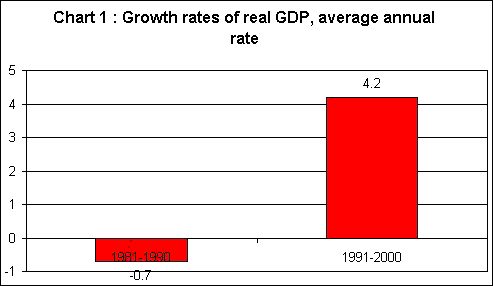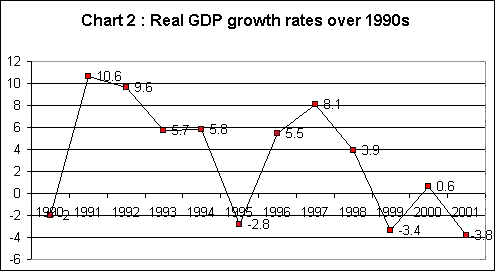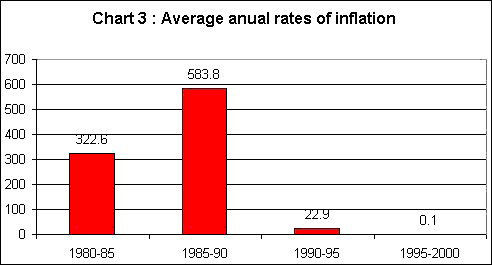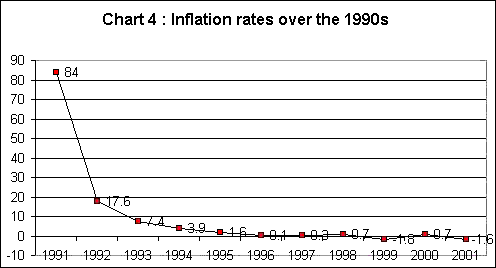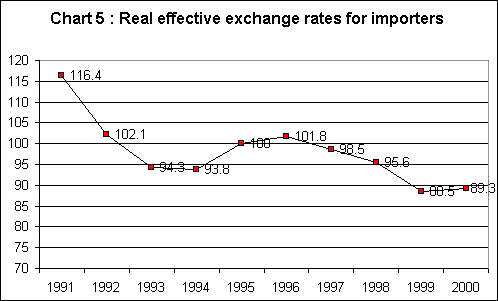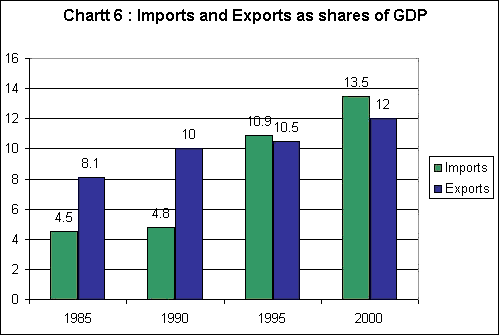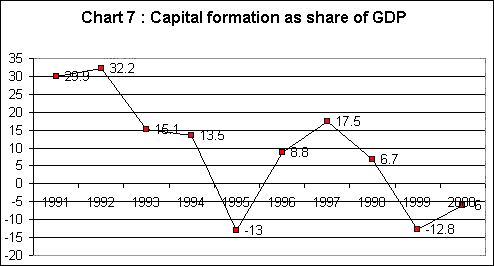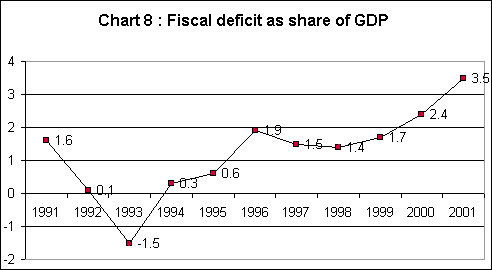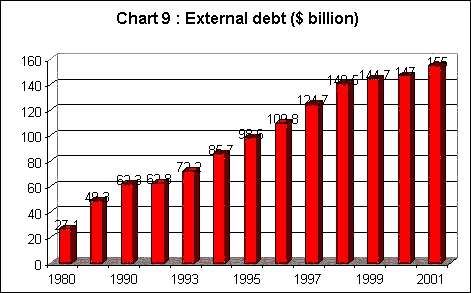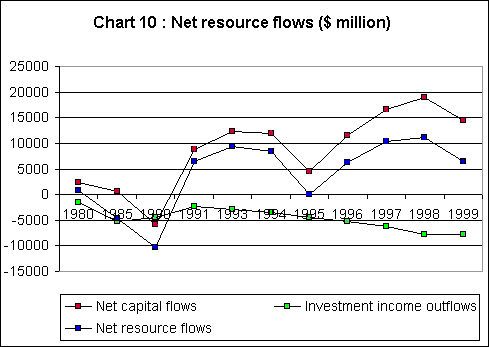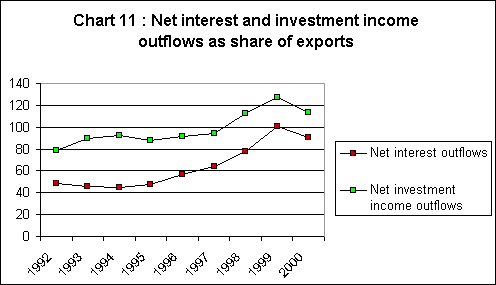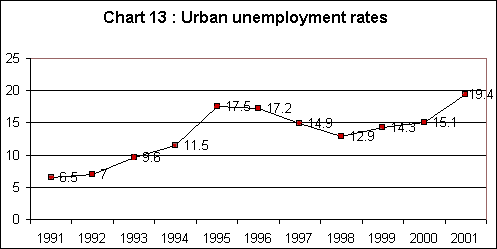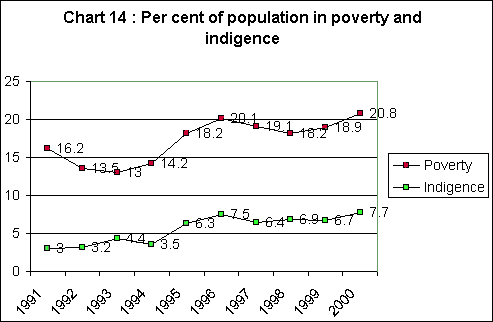The comprehensive mess
in Argentina today almost defies belief. At the turn of the year, the
financial and economic collapse was near total, with banks closed, the
state of the currency (and even its very existence) in some doubt, rapidly
increasing unemployment, decline in almost all public services and shortages
of liquidity that threatened access to basic food and necessary goods
for survival for much of the population.
The ineptitude of the previous government of President Fernando de la
Rua and Economy Minister Domingo Cavallo, and the attempt to impose further
material punishment on a society that has been so imposed upon for nearly
four years led to widespread public protests and riots that led to the
death of 25 people and have forced a change of government. But even that
government, which briefly announced that it would take measures to orient
economic policy towards Argentine people rather than to external finance,
was short-lived, with the new President surviving only a few days. At
the time of writing, the fourth President in 10 days has been sworn in,
and his new government has effectively agreed to all the conditions for
devaluation and fiscal compression that the IMF was insisting on. Of course,
the economic and political situation is still extremely uncertain and
fluid.
How did all this happen to the second largest economy in Latin America,
which was also its richest until quite recently? What were the macroeconomic
policies and processes that have led to such extreme calamity? And what
does all this imply for other countries desperate to enter or remain in
the uncertain world of emerging markets?
The unfolding economic catastrophe in Argentina provides a sharp, if alarming,
illustration of the risks inherent in a developing country’s exposure
to international capital flows and the difficulties in maintaining a stable
exchange rate in such conditions. This article examines the "convertibility"
regime which fixed the Argentine peso to the US dollar, consider the effects
on real economic activity over the 1990s and discuss the processes leading
up to the current extreme crisis.
Among the important issues that arise with reference to the Argentine
debacle are the role played by dependence upon foreign capital flows,
the nature of the fixed exchange rate regime, and the associated deflationary
macroeconomic policies that were practised over this period. In what follows,
we first describe the background and the various elements of this crisis
before considering its implications for policy in other developing countries.
The background
Argentina is no stranger to external debt crises – indeed the economy
has been on the verge of default at least six times since the early 19th
century, which must make it one of the countries most practised in financial
instability. The last time that such default seemed possible was in 1982,
at the peak of the Latin American debt crisis, when Mexico and Brazil
were also similarly afflicted, although for different reasons.
The build-up of external debt over the 1970s was closely associated with
the military regime of the dictator General Videla, who ruled Argentina
between 1978 and 1983. In this period the external debt of the country
increased from $8 billion to $ 43 billion.
Ordinary workers saw very little of the benefits from the expenditure
based on such debt – in fact, the share of wages in national income
fell over this period from 43 per cent to 22 per cent. The Argentine Tribunal
which enquired into this debt blamed not only Videla but the close economic
nexus around him, especially the then Governor of the Central Bank, Domingo
Cavallo.
The Report claimed that "The Argentine Central Bank was able to make
discretionary investments with American banks, this without securing the
agreement of the Minister of the Economy, but relying on the generous
help of the American Federal Reserve. The arrangement between these different
lead players was such that the bank loans granted to Argentina were never
to come under that country's control, but were to be directly diverted
by the banks to tax havens in the name of front- companies. So the debt
did not benefit the local people but rather the dictatorial regime and
the banks of the North which provided important technical financial support
for the passage." [Report of Judicial Inquiry into Argentine Debt]
The unfolding of that debt crisis of the 1980s meant that the country
had to submit to the ministrations and conditions imposed by the IMF,
which has been almost continuously involved with policy making and periodic
bailouts in Argentina since then. While the 1980s became a "lost
decade" in terms of real economic activity, wages and employment,
inflation continued to spiral over the period, averaging more than 400
per cent per annum over the decade.
The 'convertibility' regime
In 1991, the then President Carlos Menem (who, incidentally, was
until recently being held in custody for international arms trafficking
during 1991 and 1995) brought in Domingo Cavallo as Super Economy
Minister, largely because of his close association with financial leaders.
Cavallo then introduced the currency board system, under which the peso
was fixed to the US dollar at a one-to-one rate.
Under these arrangements - known locally as "convertibility"
- the central bank must hold one dollar in reserves for every peso in
circulation. This stops the central bank from printing money and imposes
very severe monetary discipline, in effect destroying the possibility
of any independent monetary policy. In Argentina, the system has been
slightly modified to give the bank more flexibility. Up to one-third of
the peso monetary base - pesos in circulation plus peso bank accounts
- can be backed by holdings of government bonds. Nevertheless it remains
an extremely restrictive system.
Such a system obviously also constrains fiscal policy as well, and puts
limits on government expenditure that cannot be easily financed through
taxation or borrowing. In the early 1990s the problem was "solved"
by widespread and rapid privatisation of key assets and reduction of public
services through "downsizing". This also meant an inflow of
foreign capital to buy up the cheap public assets that were on sale. However,
as would have been obvious to those with a slightly longer time horizon,
such a policy cannot be sustained once all the attractive public assets
have been disposed of and public expenditure has been reduced to minimal
levels.
It also meant that the government could not spend to lift the economy
out of recession once private sector enthusiasm paled, and the restrictive
monetary policy combined with this control of public expenditure to create
a significant downturn in economic activity by the second half of the
1990s.
Thus, while the overall picture of the 1990s shows an average growth rate
of 4.2 per cent per annum as compared with the annual average decline
of 0.7 per cent over the 1980s (Chart 1), this hides an important trend
over the decade. As evident from Chart 2, the rate of growth of real GDP
faltered in the middle of the decade, and from 1998 the economy has been
in recession which has become especially serious over the past two years.
| |
| |
Effects of macroeconomic policy
over the 1990s
It is true that the convertibility regime was successful – many would
say too successful – in curbing inflation. The rate of inflation (Chart
3) came down from the annual average of nearly 600 per cent in the late
1980s to an average of zero inflation in the second half of the 1990s.
But, as Chart 4 shows, this has actually turned into deflation over the
past three years, with prices estimated to be falling by around 1.6 per
cent over 2001. This deflation has been associated with the real economic
downturn as well.
| |
| |
The link to the US dollar – incidentally in a period when the dollar was also appreciating in world markets – meant an appreciation of the real exchange rate which the Argentine authorities were powerless to prevent. Chart 5 suggests that the real effective exchange rate facing importers appreciated by around 23 per cent between 1991 and 2000, which is quite a significant change. This made it more difficult to export goods and made imports cheaper, thereby substituting for domestic production (especially employment-intensive small-scale production).
| |
| |
The consequences were apparent in the trade patterns.
It can be seen from Chart 6 that while the share of imports in GDP nearly
tripled over the 1990s, from 4.8 per cent to 13.5 per cent, the share
of exports increased only marginally from 10 per cent to 12 per cent.
This also meant that the trade balance, which had earlier been positive,
turned negative by the end of the decade.
It is not surprising then to find (from Chart 7) that investment activity
slackened dramatically over this period. Not only did the fiscal stimulus
to investment decline, but the monetary stringency and the movement of
the real exchange rate combined to reduce the rate of capital formation.
This was not only highly unstable especially in the latter part of the
1990s, but actually turned negative over several years in the recent past.
| |
As we have seen, there were severe limits on fiscal
expansion as a means out of the stagnation or recession. Some analysts
have blamed fiscal profligacy for the current severity of the debt problem,
but nothing could be further form the truth. Far from engaging in irresponsible
expenditure, the government instead committed itself to what has been
described as "reckless rectitude", persisting in spending cuts
which have already almost destroyed the public education and health systems,
and drastically reduced the availability of most other public services.
In fact, as can be observed from Chart 8, the fiscal deficit remained
well under 2 per cent of GDP over most of the decade (and was even surplus
in one year) which is not only less than most other developing countries
but also less than the European Union and OECD averages. The only reason
it increased subsequently, and is now estimated to be around 3.5 per cent
of GDP, is not because of increased public expenditure but because of
sharply reduced tax collections as the economy has contracted. The tax
revenues until November 2001 were estimated to be 25 per cent below their
level of the previous year.
| |
| |
Inability to raise tax revenues because of declining economic activity meant that the government was forced to undertake expensive borrowing to finance whatever deficits it did manage to run, and this debt was contracted on increasingly onerous terms. Chart 9 indicates how the external debt more than doubled over the decade to reach $155 billion at the present time. Much of this was simply earlier debt that was rolled over at higher interest rates. A feature of the convertibility regime was that even a lot of the domestic public debt – payable to Argentine resident savers - was contracted in dollars.
| |
Interestingly, all this self-imposed economic pain
did not lead to a huge increase in foreign resource inflows, despite Argentina
being officially declared to be a "model economy" by the IMF
and private financial analysts in the mid 1990s. It would be evident from
Chart 10 that the net resource flows (that is net capital flows minus
outflows of investment income such as profits and interest) were relatively
meagre over the 1990s. This was not only because the net capital inflows
themselves were both low and volatile (because of substantial outflows
by residents) but because of the growing burden of investment income payments.
Chart 11 gives some idea of how much these latter payments have come to
matter for Argentina. By the end of the decade, interest payments alone
were as much or slightly more than the total value of exports, while total
investment income outflows were substantially greater. Of course, this
also suggests why default could even be a feasible option for the economy
now, when interest payments alone have come to dominate over export receipts.
| |
Inevitably, the economic decline has been reflected in rates of employment generation. Chart 13 shows how rates of urban employment (as per cent of population) first were stagnant and then declined over the 1990s, while rates of open unemployment have ballooned from 6.5 per cent at the beginning of the decade to nearly 20 per cent at present. Even this hides the true extent of job loss, because studies indicate that there has been a substantial move from regular to more casual and precarious forms of employment including part-time work. Wage incomes have been doubly affected: the average wage in real terms is now worth half of its 1974 value.
| |
Associated with all this there have been increases in poverty. In Argentina, data are collected on both indigence (the people with incomes insufficient to ensure consumption according to minimum nutritional norms) and poverty (which also includes along with food, a complementary set of goods and services such as clothing, transport, education and health). As can be seen from Chart 14, both indices have increased over the 1990s, but the increase in indigence has been especially sharp.
| |
The present impasse
Obviously, an economy with the features described above was heading for
trouble in any case. But the severity of the current crisis reflects other
features as well. The proximate cause of the current financial crisis
was the refusal of the IMF to make a payment of $1.26bn due in the middle
of December because of Argentina's deteriorating accounts and its refusal
to consider a devaluation. It is interesting that the IMF took this stand
: after all, it was the IMF which first championed and then supported
the highly restrictive macroeconomic austerity measures Argentina undertook
to support the Currency Board, and praised the anti-inflationary bias.
This immediately put the government’s ability to service its huge debt
in jeopardy. In response the Government imposed drastic measures. Already,
for more than a year, Argentina had depended on local banks and pension
to finance government spending and meet payments on its debt. After the
IMF announcement, the government took control of $3.5bn in private pension
assets to pay bills. In mid-December, $900 million interest on foreign
debt was paid using the money confiscated from private pension funds and
by pressurising domestic banks to roll over Treasury bills.
By the end of the year, it has been estimated that $12 billion would have
been paid to foreign creditors, even as domestic capital has been fleeing
the country. The insistence on avoiding a technical default thus meant
a clear preference for the interests of foreign investors over the domestic
population. It is interesting that this persisted even though the financial
markets themselves discounted the debt : Argentine bonds in December were
trading at 30 per cent higher spreads than US Treasury Bonds, suggesting
that they were seen as near-impossibly risky.
There were new banking and exchange restrictions as well. Bank account-holders
were limited to withdrawing $250 a week in cash. Any amount above that
would have to be spent by cheque, credit card or debit card. In addition,
Argentines were allowed to take no more than $1,000 in cash abroad. Companies
would have to obtain official clearance to make foreign payments above
that amount.
These measures almost brought to a standstill the informal economy where
increasing numbers of Argentines, since this was heavily cash dependent.
And this meant further job loss and firm closures. Cavallo’s last plan
was to try and balance the budget for next year by cutting spending by
$9.2 billion (that is by one-fifth of the current level) and imposing
new taxed for more than $4 billion. This would obviously mean even lost
jobs, unpaid pensions, and further cuts in basic services.
There was violent public reaction to these measures, which involved huge
demonstrations and even riots, and which culminated in the eviction of
the government of Fernando de la Rua and Economy Minister Domingo Cavallo.
However, the basic economic problems are far from solved.
There are various alternative strategies to deal with the current mess.
One is to stick to the currency peg and even enforce it through complete
dollarisation, which would involve even more of the same economic treatment
as before. Another, which has been suggested by some Argentines, would
be to devalue and then dollarise, since there is now no faith in the Argentine
currency. A third alternative, which would entail at least a partial of
temporary default at the very minimum, would be to convert all debt into
peso debt. The question then would be whether to allow the peso to float
freely (which would necessarily entail a big and possibly rapid devaluation)
which could create huge instability, or try and monitor the level by administering
the exchange rate.
None of these options is particularly attractive for ordinary Argentine
people, since all of them would imply some additional economic pain. Dollarisation
is obviously the worst option, since it imposes even greater austerity
on an economy that is already reeling. In any case, it does not ensure
future stability. Even if it is argued that in future the economy would
avoid financial meltdown, a fiscal collapse is still quite feasible under
dollarisation.
Of course, there were already ways of working around the convertibility
regime. Several cash-strapped provinces had begun to pay their workers
in bonds that could be used to buy goods and act as quasi-currencies.
Some have suggested that these could be expanded to become a third, floating
currency that would inject liquidity into the economy and slowly replace
the peso. However, the IMF already insisting that such scrip is accounted
as part of the fiscal deficit.
Devaluation – or allowing the currency to float -has the problem that
it is not clear whether the peso would then go into free fall, in the
manner of the Turkish lira a few months ago, creating even more instability
and completely wrecking the financial system. Also, since so much of the
internal debt is also denominated in dollars, working out ways of dealing
with this that also preserve the value of pensions and other payments
to the poor would be a problem.
While it is clear that none of the alternatives mentioned above are
complete solutions, the very severity of the Argentine problem may in
some ways make a more lasting solution more possible. Very few economies
in the world today would dare to institute sweeping exchange controls
and limits on capital flows, nor would many dare to fix the value of the
currency. In Argentina at the present time, all of these are in place.
It is even possible for a government that is sufficiently daring – and
sufficiently concerned for the welfare of its own citizenry – to attempt
to use these to its own advantage.
During the December crisis a range of financial and currency restrictions
were imposed on Argentines. While these measures did not resolve the crisis,
they almost brought to a standstill the informal economy where increasing
numbers of Argentines. The IMF style measures which were then proposed
meant further job loss and economic distress. There was violent public
reaction to these measures, with huge demonstrations and even riots, which
culminated in the eviction of the government of Fernando de la Rua and
Economy Minister Domingo Cavallo. However, the basic economic problems
are far from solved.
The current government has just announced that it will follow the IMF
prescriptions by devaluing the currency sharply and imposing further cuts
on government spending. While this will certainly mean economic disaster
for many ordinary Argentines, it is still not clear that the peso will
not go into free fall, in the manner of the Turkish lira a few months
ago, creating even more instability and completely wrecking the financial
system. Also, since so much of the internal debt is denominated in dollars,
working out ways of dealing with this that also preserve the value of
pensions and other payments to the poor is a problem.
But this policy was not by any means the only alternative. In fact, the
very severity of the Argentine problem in some ways made a more lasting
solution more possible. Very few economies in the world today would dare
to institute sweeping exchange controls and limits on capital flows, nor
would many dare to fix the value of the currency. In Argentina at the
present time, all of these are in place. It would even have been possible
for a government that is sufficiently daring – and sufficiently concerned
for the welfare of its own citizenry – to attempt to use these to its
own advantage.
Thus, the new Argentine government could, in fact, choose to peg the exchange
rate at a certain level which it thinks appropriate, and strictly enforce
currency and capital controls to ensure its stability while it deals with
the domestic crisis. It could use fiscal stimulus to revive the economy
– just as President Bush is trying to do in the US – and allow this revival
also to sort out the fiscal problem over time. And it could go in for
huge injections of fresh capital to keep the banking system afloat without
which economic activity would again splutter.
If the new government actually managed to do all this and this proved
to be both feasible and a way out of the crisis, Argentina might actually
become a model for other developing countries to emulate. But at present,
the lesson from Argentina is very different.
What this entire experience highlights is the danger of relying on open
capital flows in any attempt to achieve stable economic growth. It is
not just that the "unholy trinity" of fixed exchange rate regime,
capital flows, and public debt is unsustainable. It is also that, with
open capital flows, even a flexible exchange rate regime does not necessarily
ensure stability, and can even involve more volatility depending on the
uncertain whims of international investors. So, it is not TINA ("There
Is No Alternative") but rather ARGENTINA, which shows that this policy
can only lead to disaster.
